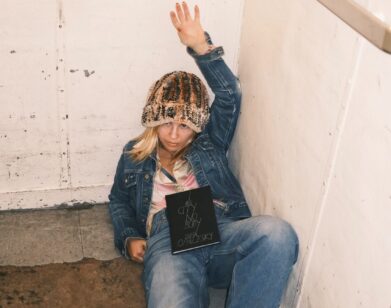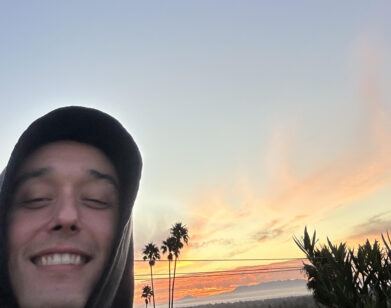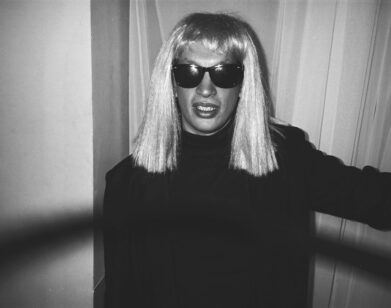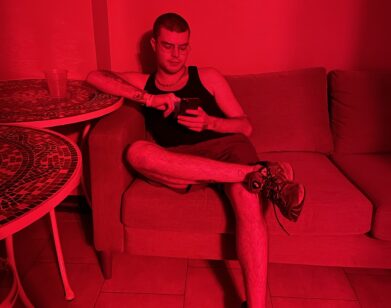A maybe exaggerated, definitely foggy,look back at The World—the mosticonic nightclub you’ve never heard of

Located in a crumbling former wedding hall in Alphabet City, the World was the most iconic nightclub you’ve never heard of. It was, in its relatively short life, a bacchanalian birthplace of the hybrid culture that now defines our post-internet era. At the World, Björk made her American debut in the Sugarcubes. Talking Heads and Devo filmed music videos there. Public Enemy played there. So did David Bowie, beneath a precarious two-ton chandelier that seemed poised to crash at any moment. Prince, Grace Jones, and Madonna were all regulars. On any given night, there was a collision of house music, hip-hop, rock, drag, and punk.
Spearheaded by Arthur Weinstein, a club owner and man about town from the Bronx, the World first went into operation at some hazy point in the mid-1980s. It began first as an on-and-off music venue and later as a full-time nightclub. Together with his wife, Colleen Weinstein, a commercial decorator who would later be responsible for the interiors of nightclubs such as Limelight and Marquee, Arthur transformed the World into an impeccably depraved playground on a shoestring budget.
The World was almost called “The End of the World,” which was what the neighborhood felt like back then. A sense of lawlessness pervaded the club’s surroundings, block after block of burned-out buildings that had already become a breeding ground for artist-driven nocturnal innovation. The Pyramid Club, a few blocks over on Avenue A and 6th Street, opened in 1979, and 8BC had a brief run from 1983 to 1985. Building on the culture of these spaces and others like them, the World brought together avant-garde weirdos, celebrities, and black and Puerto Rican locals, as well as the uptown crowd. The resulting alchemy often led to snorting, stripping, and full-on fucking. That is, until shortly after midnight on June 28, 1991, when one of the club’s owners was found dead, shot three times, on the club’s balcony.
———
COLLEEN WEINSTEIN (nightclub decorator): I think it was about 1982. My husband, Arthur, and I had the Continental, which was an illegal after-hours club on West 25th Street, and we were living on 2nd Avenue and 11th Street. We had a very nice neighbor whose name was Raymond. One of his friends had found this place on the Lower East Side. He took my husband down to the space. It was huge, old, and cavernous. We immediately fell in love.
STEVE BLUSH (music writer and filmmaker, son of the owner of 254 East 2nd Street, the building that housed the World): My dad was one of those colorful Lower East Side characters. Later in life, he started making a bit of money flipping buildings. He somehow stumbled across this old Jewish wedding hall. It was like a shipwreck. There was all the fine china and crystal laid out with a layer of dust an inch thick. My dad liked Arthur. Back then, nightlife was a mafia thing, but Arthur and Colleen were trying to do something different. They were artists.
COLLEEN WEINSTEIN: Arthur was a photographer. He projected a lot of slides in the main room of the World as décor. When photos are projected in a huge space like that it’s wild. They take on the shape of the architecture. His forte, though, at all his clubs, was always the mixture of people—different ethnicities, different economic statuses, public figures.
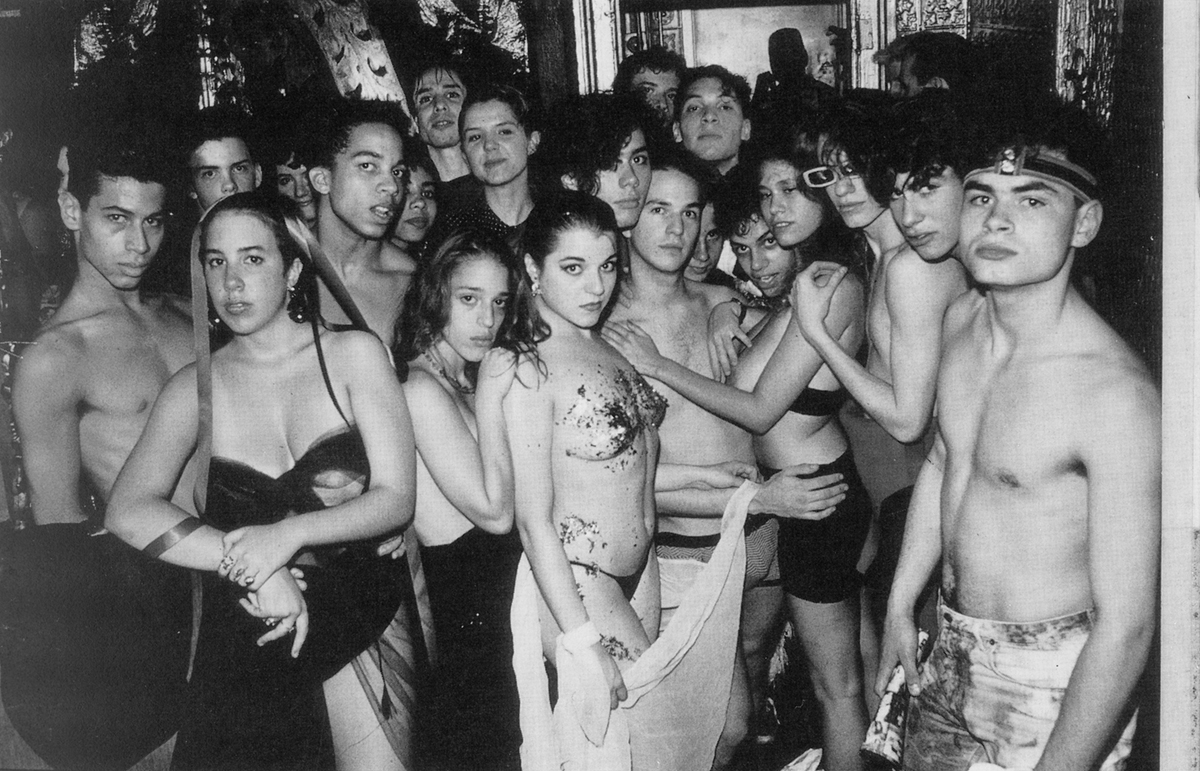
A cuddle cloud of club kids coalesces at the World.
ZALDY (fashion designer and former club kid): The World was an amazing melting pot of people. There was something about the space. It was so decadent in the way that it had real faded glory. There were chandeliers and balconies and gold coming off the walls, like you were in a palace. Something about it felt very much of the time. It was glamorous, but a dirty glamour.
SANDRA BERNHARD (actress and comedian): The World had that gritty patina that the ’80s were all about. I had my birthday party there on June 6, 1988. We had dinner first at Canal Bar and then headed to the World. They opened just for us. It was the kind of intimate thing you could do, you know, before Instagram. We spun some records and danced. It was always fun to go out with Madonna because she loves dancing.
“You had drag queens, trans girls, and club kids mingling with homeboys and slumming socialites—especially when those socialites needed a fix.”—Lady Bunny
LADY BUNNY (drag queen and creator of Wigstock): The East Village was very decadent back then. You had drag queens, trans girls, and club kids mingling with homeboys and slumming socialites—especially when those socialites needed a fix. One night at the World, RuPaul, Lahoma Van Zandt, and I lured this gorgeous black guy with a mouth full of gold fillings into the bathroom. Honey, we were all drooling at this point. As we prepared to do the do, he removed from his sweat pants not his penis but his gun. We watched in horror, but slightly turned on. I don’t think he wanted to kill us—I think he wanted to fuck us—but you had to have some street sense to hang at the World.
LINDA SIMPSON (drag queen and nightlife archivist): Back then, Alphabet City was extremely dangerous and you really took your life into your own hands walking to the World. You’d have to make your way past drug dealers, crazed addicts, burnt-out buildings, and flaming trash cans.
SOPHIA LAMAR (club legend): I remember how hard it was to arrive at the World without getting mugged. Back in those days, Alphabet City was very dangerous. My first time at the World, I was greeted at the door by International Chrysis and Leigh Bowery, but then something got my attention—they were playing heavy metal and rock ’n’ roll.

A man of the World.
CARLO MCCORMICK (cultural critic and curator): Over the years at the World, I saw a very late-in-life Nico, the Sun Ra Arkestra, and a very cranky Neil Young, who did five shows in four nights, performing only the songs from one of his most widely despised records.
AMANDA DEMME (photographer, creative director, and former door girl at the World): I came to New York in 1987. I was a kid, 20 years old and doing the door for the biggest fucking club on the Lower East Side. It inspired so many other promoters and club owners—also for me when I started my own hip-hop Car Wash. It showed us that you could go into any raw space‚ any school or abandoned auditorium, and start throwing parties. The World was a launching pad for a lot of people.
DAVID BYRNE (artist and Talking Heads frontman): We shot the video for “Burning Down the House” at what became the World. I believe it wasn’t open yet. I was on tour a lot then, so I’m not sure I ever frequented the club.
“Everybody liked seeing a gangster blowing $20,000 on club kids while laughing his head off on ecstasy.” —Steve Lewis
STEPHAN LUPINO (nightlife photographer and artist): When the World opened, the owners said, “Oh, Stephan, you have to shoot at our club.” I started working on a book of photos. At the launch party for the book, Frank Zappa and Christopher Walken were there. Mick Jagger said to my friend Jimmy Rip, because they were watching how I was shooting: “I want to know how Lupino gets all those girls to take their clothes off.”
STEVE LEWIS (career nightlife professional and former director at the World): Prince was a regular. You’d see Malcolm Forbes chatting about the Yankees with two street kids in Yankees hats. This was the place. Everybody liked seeing a gangster blowing $20,000 on club kids while laughing his head off on ecstasy.
KAREN FINLEY (performance artist): The World was about sweating together in a space. Partying and having fun together opens up the city. Drinking, drugs, or the ecstasy of movement—it all changes your consciousness. Having the body in a mass is saying we want to be here together, physically as one, breathing and living.

Zoë Tamerlaine and a group of nonplussed bystanders.
ANN CUMMINGS-ELWOOD (former door girl and V.I.P. hostess at the World): You’d see the Clash, Andy Warhol, Run-DMC, the Beastie Boys, or Judd Nelson in the V.I.P. One night I got Public Enemy to play, so we were giving the whole V.I.P. room to them and their friends. There was this Euro couple, I didn’t really know who they were. They were uptown people, but they were actually kind of famous—Reinaldo Herrera and Carolina Herrera. I didn’t let them into the V.I.P. room, so Steve Lewis freaked out over that and fired me.
STEVE LEWIS: Carolina Herrera showed up one night wearing, I think, the jewels Queen Isabella hocked to pay for Columbus’s journey to America.
COLLEEN WEINSTEIN: The jewels had been the Duchess of Windsor’s. Sotheby’s had a Duchess of Windsor auction, and Reinaldo bought Carolina a piece with a giant emerald. She was wearing it that night, and I remember going over to Arthur and being like, “When they are ready to go, let’s make sure she gets out of here with that necklace on her neck!”
CHIP DUCKETT (theater producer and organizer of AIDS benefits at the World): The World was a big mess in a lot of ways. The janitor was a junkie who lived in coat check. He would come out at 1am and walk around shaving. One week we all got paid in counterfeit money. I got a phone call from the It Twins, the club kid brothers who did the door to the “It Club,” the sort of V.I.P. club-within-a-club at the World. They were like, “Don’t bother trying to deposit the money. We went to the bank and they seized it.” There was a bathroom that overflowed and was never really fixed. I actually saw somebody pee on the dance floor once instead of going to the bathroom.
“Dean Johnson was a 7-foot-tall drag queen with a bald head, a huge cock, and a rock band.”—Tabboo!
TABBOO! (artist and ’80s drag queen): Dean Johnson was a 7-foot-tall drag queen with a bald head, a huge cock, and a rock band. So they said, “Why don’t you do a gay night? Let’s get that gay money.” I was the hostess. I worked the mic introducing everybody. Dean brought in the most incredible transgender performers. All the queens from different clubs would give shows. International Chrysis was the queen of the scene. She was so beautiful. You would have Romy Haag from Berlin—she was David Bowie’s lover in the ’70s. And you had Jayne County, the preeminent transgender rock star who used to play at CBGB.
MICHAEL MUSTO (music and nightlife journalist): I loved Dean Johnson’s weekly Rock ’n’ Roll Fag Bar party. Dean would take the stage with his group, the Weenies, and sing songs full of witty rage. As AIDS kept mounting and activism was growing, this was a cathartic party into which we could channel all of our mixed feelings. For some time, there was a back room area with a monitor who was supposed to make sure there were “no lips below the hips.” They weren’t always so vigilant.
LINDA SIMPSON: The party had a very rambunctious, sexy atmosphere, with lots of go-go boys. There were at least a dozen onstage, all in their tighty-whities and hiking boots. That became a very iconic gay look for that era.

Julie Jules, the ’80s it-girl who spoke with a fake Russian accent, provides table service.
DESMOND CADOGAN (former go-go dancer at the World): I helped Dean Johnson book go-go dancers until he insisted I become one myself. I guess he thought me and Derek Yarritu would be a good pair. When we took our breaks, we could go right across the street, hop the fence of the Pitt Street pool, and go for a swim in the summertime. We were only supposed to be wearing tight, white briefs, so our tips went up after our swim.
DEREK YARRITU (personal trainer and former go-go dancer at the World): I was strung out and homeless and living in the Jane West hotel. You could rent a room for three nights there for $70. I had a copy of the Village Voice and I read about the Rock ’n’ Roll Fag Bar poster boy contest, and I was like, “I could probably do that.” It was a time when there were a lot of people who were able to live very cheaply and they were able to commit to whatever their artistic vision was. New York was definitely different then. Think 1988, 1989—the health crisis is happening and yet there’s a room at the World, at a social event with celebrities, where there is actual sex happening.
CHIP DUCKETT: I was throwing a birthday party for myself at the World and 2,000 people ended up attending. I gave the money we made to the Bailey House, which was one of the city’s first residences to house homeless people with AIDS. Then I started throwing more benefits. I did a series themed around the seven deadly sins. Anger was a benefit for ACT UP. For Gluttony, I had go-go boys standing in children’s wading pools in their underwear pouring chocolate syrup over themselves while people licked it off. For Greed, we played the song “Money” from Cabaret, and at the end we dropped 2,000 one-dollar bills onto the dance floor.
“Disco and punk, those worlds were dying and it was becoming more about freaky glamour.” —Zaldy
ZALDY: Disco and punk, those worlds were dying and it was becoming more about freaky glamour. I remember wearing theater bloomers with a black dracula cape that I found in the garment center at FIT. I’d safety-pinned them all down and wore this gold crown. I was actually photographed on the balcony of the World for an article about club kids for New York magazine. I wanted to be photographed at the World because it was my favorite. All the other clubs were on the West Side, but the World was all the way east. If you were going to the World, you knew you were going to walk home in the sunlight.
STEVE LEWIS: No one else was really playing house music at the time. It existed at Paradise Garage and an after-hours called Black Market. We imported Frankie Knuckles from Chicago for Fridays and for Thursdays we hired David Morales, a Latin freestyle DJ from New York.
DEREK YARRITU: I remember when the Atlanta crew showed up. When RuPaul first came to New York, her look was ahead of its time. It was sort of like Olivia Newton-John in the “Physical” video, but with a Nerf football split down the middle as her chest.

Stephan Lupino’s original caption for this photograph reads “Zaldy: A fashion victim.”
LARRY TEE (DJ and club promoter): With Celebrity Club, every week we celebrated a star like Dianne Brill, Rudolf, Deee-Lite, Diamanda Galás, or Michael Musto. Michael [Alig] sometimes put out dog food as chip dip and was known for offering piss from a champagne bottle. Each week, RuPaul and Lahoma would get boys from the audience to take off their clothes for the hot body contest and douse them with water. At the time that wasn’t so cruel because the room was so hot. You needed a bath to stay refreshed.
ANN CUMMINGS-ELWOOD: I remember one of my security guards once asking, “Do we let the Beastie Boys in for free?” The Beastie Boys in 1985 were not going to get into anything uptown. Only downtown did anyone know who they were. The whole rap community converged at the World at that time. Public Enemy played there. Run-DMC. LL Cool J. The World played a part in bringing rap downtown so people could start hearing it and it could filter out to the suburbs.
NICK ZEDD (artist and filmmaker): In 1989, I went to the World with a girl named Shaolin to see Public Enemy play a New Year’s Eve show. At the time, all rap groups were completely unwelcome in Manhattan in any venue. We arrived at 10pm and were subjected to an absurd frisking procedure by security goons who dumped out the contents of Shaolin’s designer fish purse and confiscated her can of mace. Then they ushered us into a dismal ballroom with a lot of bored-looking people milling around while stale disco music assaulted our ears. Everyone expected Public Enemy to go on before midnight to celebrate the new year. At midnight, nothing happened. Decades later, I still wonder if Public Enemy ever deigned to appear onstage.
COLLEEN WEINSTEIN: Because the space had been a catering hall, there was a big kitchen that became like an underground V.I.P. area. V.I.P.s flocked not where we made the gorgeous V.I.P. room, but next to the boiler down in the basement. One night Bill Murray was down there in the kitchen, and my husband was called to the front door because the cops were there. They started in the kitchen with their flashlights. This was right after Ghostbusters had come out and they flipped when they saw Bill. He picked up on it: “Officers, what’s going on, guys? There’s no ghosts in here!”

Mark Mothersbaugh of Devo with Jane, whose last name is unknown.
DESMOND CADOGAN: The police didn’t show up to the World in the beginning. Then it was discovered by the hip-hop community and the police started getting involved.
TABBOO!: Not only that club, but the entire city, especially the East Village, changed. Everyone was dying of AIDS and of overdoses. The city was coming in. They started “cleaning up” the neighborhood. Back then every block was half-collapsed with a burning car out front. Now it’s baby carriages and designer dogs.
STEVE BLUSH: When the city revoked the club’s licenses, the World’s owners stopped paying their rent. The neighborhood was upset. My dad was in the middle of selling the building to a church in ’91 when the new manager [Steven Venizelos] was shot dead inside the club.
STEVE LEWIS: A lot of people wanted to kill me when I left that place, but the guy who came in, his name was also Steve. When they shot him, it took a lot of heat off me. People heard, “Steve got killed.”


